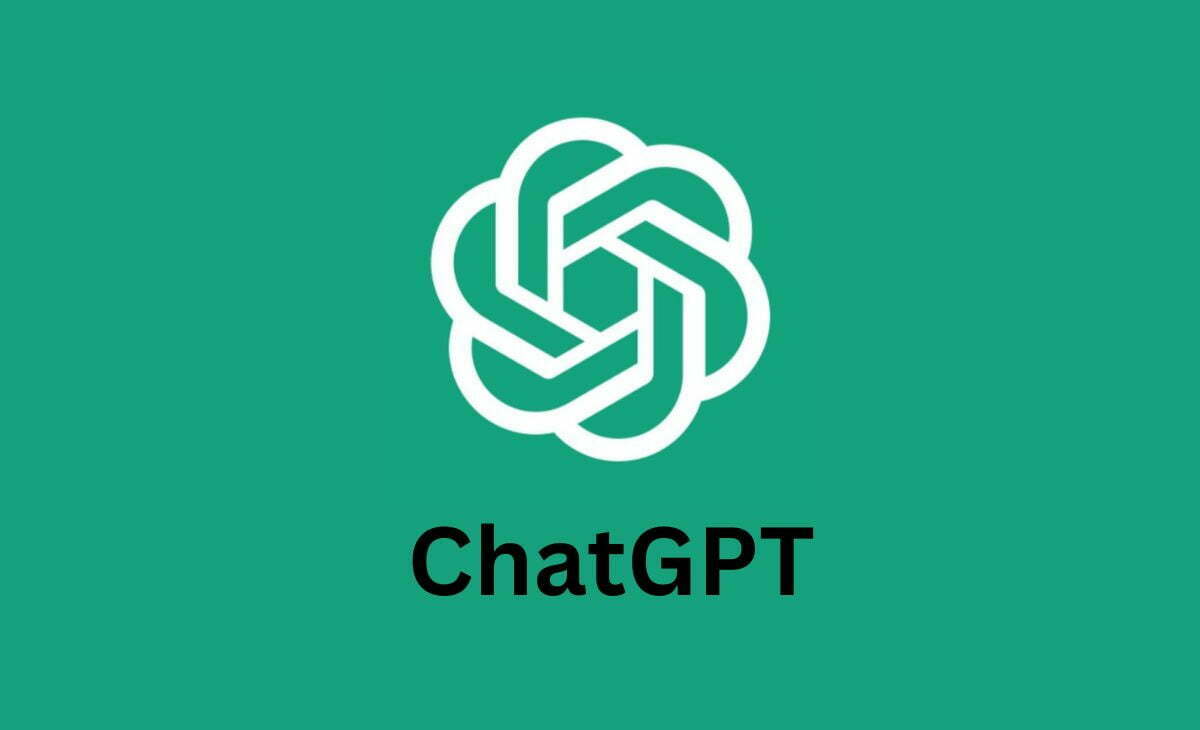By now, I’m sure you’ve probably heard about ChatGPT and the boom of AI. It can be easy to dismiss new technology as just a passing fad, but I have to be completely honest — I’m obsessed with ChatGPT and you should be too.
This thing can do basically anything — writing blog posts, ads, and emails with ease. ChatGPT can even code landing pages, create website navigations, and give you a full business plan.
With capabilities like those, ChatGPT is impossible to ignore — especially for marketing agencies like us. But do you know what it takes to prompt ChatGPT to give you what you’re looking for? This blog post hopes to answer how you can write ChatGPT prompts like a pro.
Use appropriate tone and language
When writing ChatGPT prompts, it’s important to use language and tone that is appropriate for your audience and the context of your prompt. This includes avoiding offensive or inappropriate language, as well as using a tone that is respectful and professional.
Additionally, it’s important when addressing ChatGPT to remember that it’s an AI language model — not a human being. Because of that, it’s best to avoid using overly emotional or informal language. This can lead to confusion or inaccurate responses. Instead, try to use clear and direct language that communicates the intent of your prompt in a professional and respectful manner.
Write ChatGPT prompts to be specific
A major step in writing effective ChatGPT prompts is to be specific. The more specific your prompt is, the better the response from ChatGPT will be.
Part of being specific is avoiding ambiguity. For example, let’s pretend you work in the marketing division of a banana company and you’ve been tasked to produce copywriting for an ad campaign on Facebook. Images are all ready to go so no need to worry about that.
The first thing I asked ChatGPT was ‘can you give me something for a banana ad on facebook?’
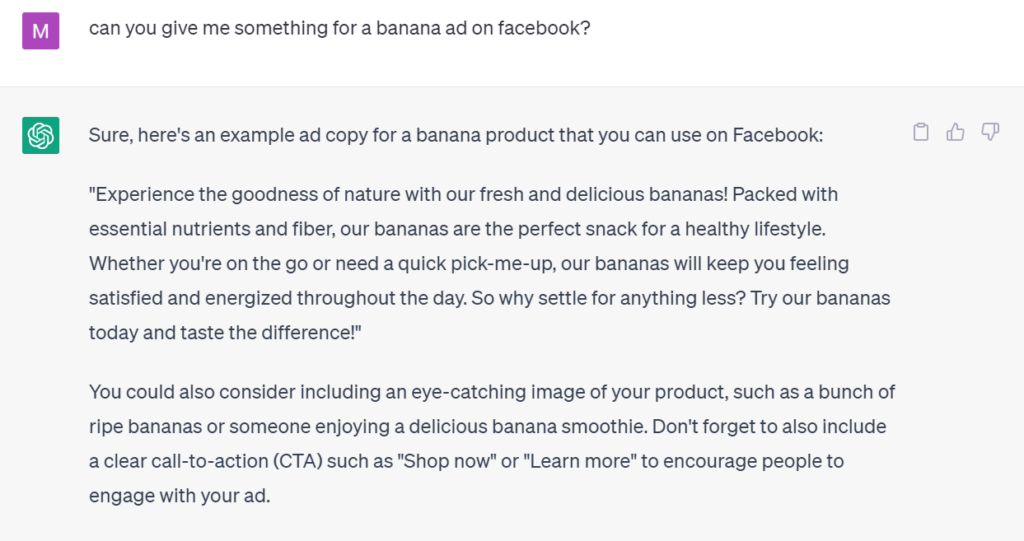
Let me be clear, this is a bad prompt to ask ChatGPT. ChatGPT is becoming smart enough that it was able to figure out that ‘something’ here meant copy but you should NOT be using words like ‘something’ when prompting ChatGPT. If you want ad copy, tell it you want ad copy.
Being specific can also mean giving ChatGPT more refined details about what you want your output to look and sound like. I’m going to give ChatGPT a series of similar prompts with more and more detail to demonstrate this.
Example 1
Write me an ad promoting bananas.
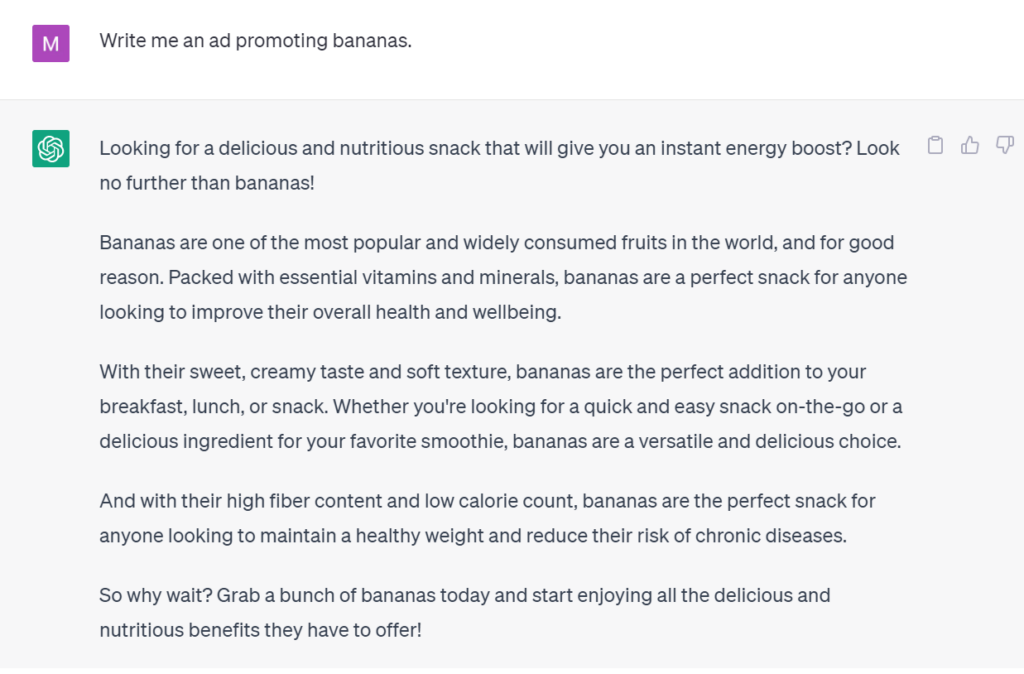
We gave ChatGPT a pretty generic prompt, so it gave us a pretty generic response. There’s nothing wrong or embarrassing for the company if this copy was posted with the ad, but this is uninspired copy that would not grab the attention you’d like to see from an ad campaign.
The copy is also longer than you’d like for a Facebook ad. Ideally we’d like to see a headline of about 40 characters, a body text of about 125 characters, and link text of about 30 characters for each ad.
Example 2
Write me 5 facebook ads promoting bananas and please include a headline of 40 characters, a body text of 125 characters, and link text of 30 characters for each ad.
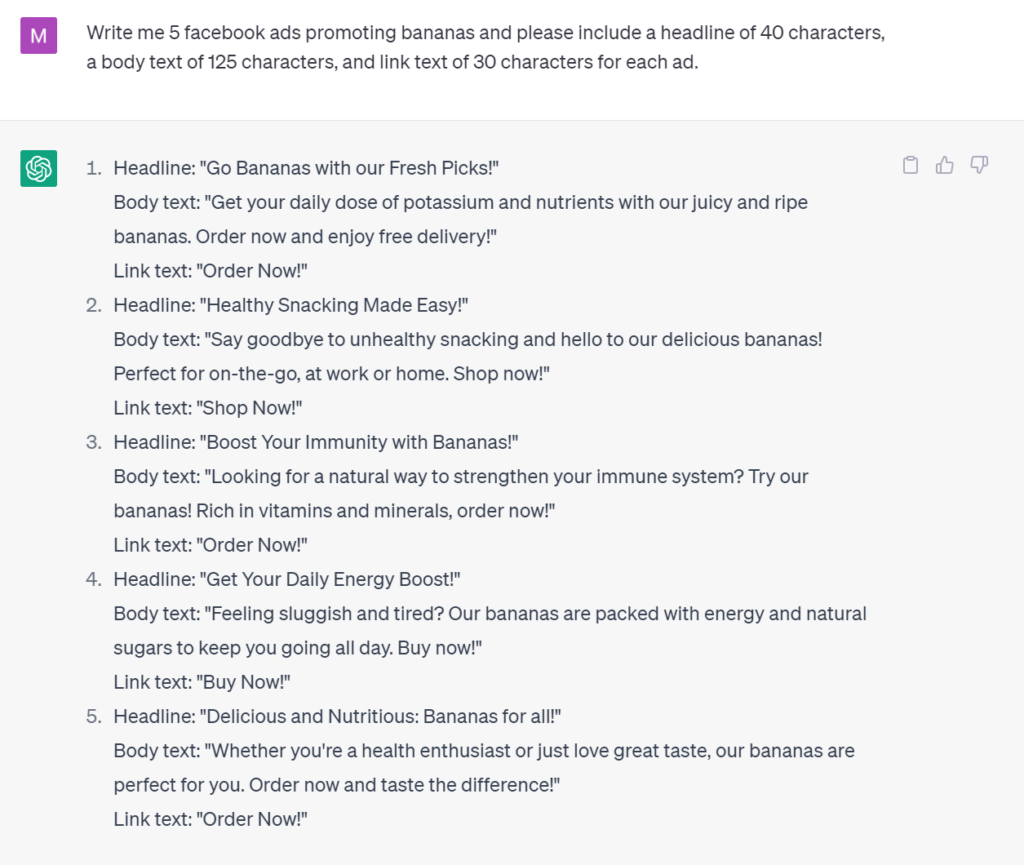
Now we’re a bit closer to what we’re looking for. Notice that I not only asked for a specific length for each section of the text, but also the specific number of iterations I would like it to produce.
As for the copy itself, we’re still desiring a bit more on the engaging and attention grabbing front. We’d like to see a bit more personality for our ad copy than what’s being given here.
Example 3
Write me 5 humorous facebook ads promoting bananas and please include a header of 30 characters, a caption of 50 characters, and link text of 30 characters for each ad.
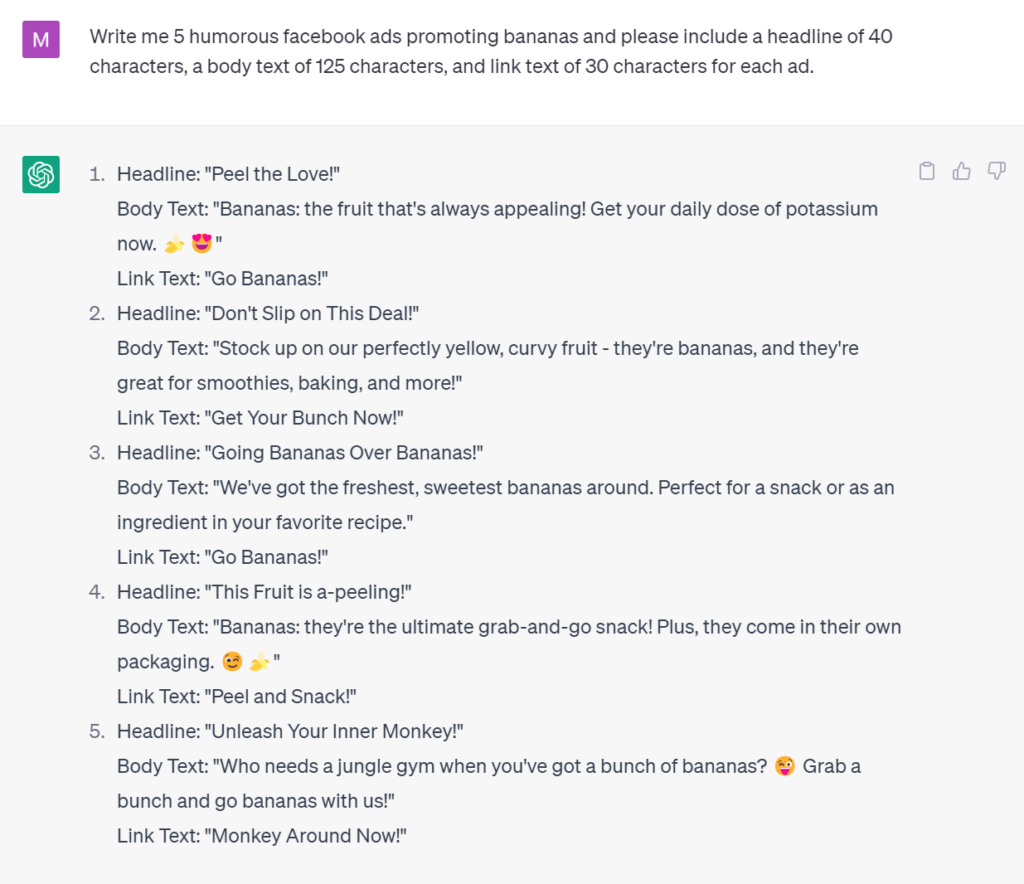
We’re really getting somewhere now. Everything is the right length, appropriate variation is provided, and we’re starting to see some personality come through.
Although this is a great foundation, I can’t help but question if we can take this one step further.
Example 4
Write me 5 humorous Facebook ads promoting bananas and please include a header of 30 characters, a caption of 50 characters, and link text of 30 characters for each ad. While humorous, the ads should still use professional language and be appropriate for a business setting.
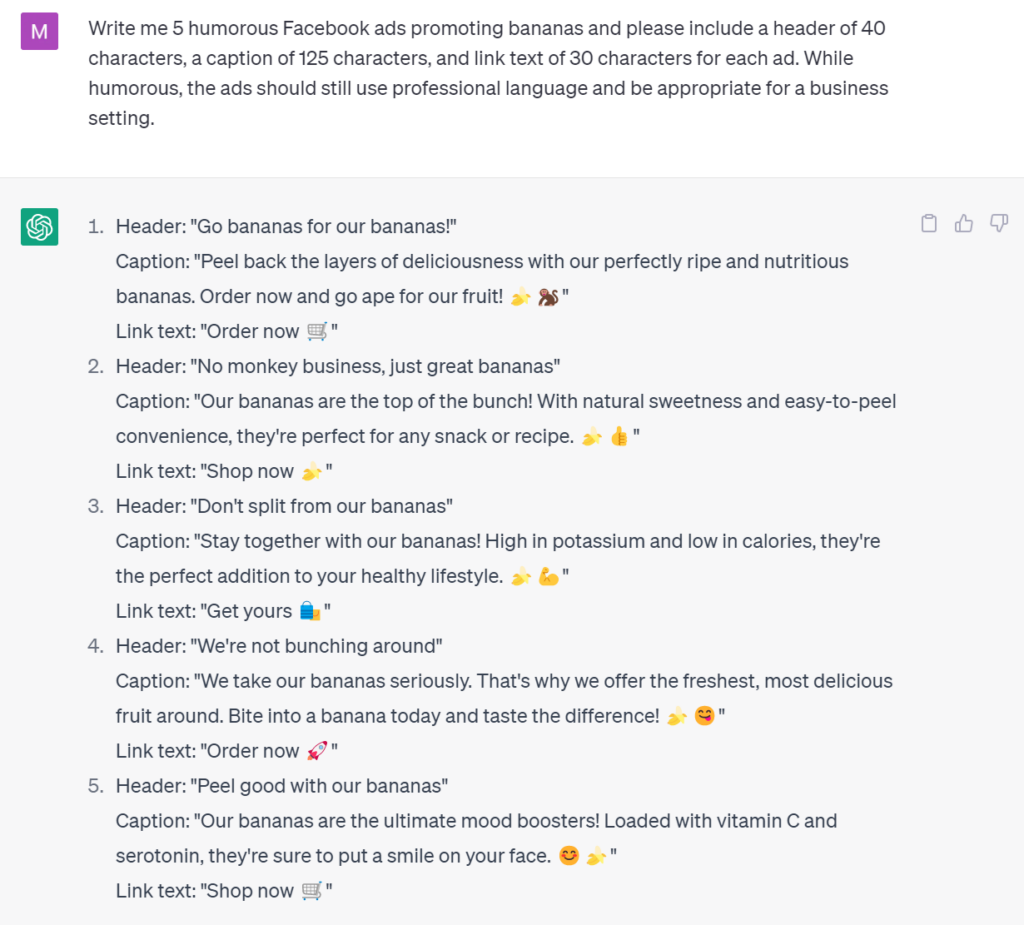
The more you give ChatGPT, the more it gives you. By asking it to write in a more professional tone for a business setting, ChatGPT reacted by notching the humor down and getting a bit more serious about how much bananas mean to them. One of the body texts now literally includes “We take our bananas seriously.”
It also took the extra effort to add emojis for every body text and link text instead of sparsely like the previous example. Although this may not match every brand personality, using emojis in a business setting can be quite effective. For this example, the emojis really liven up the copy and help give the personality we’d been craving from the start.
Provide context
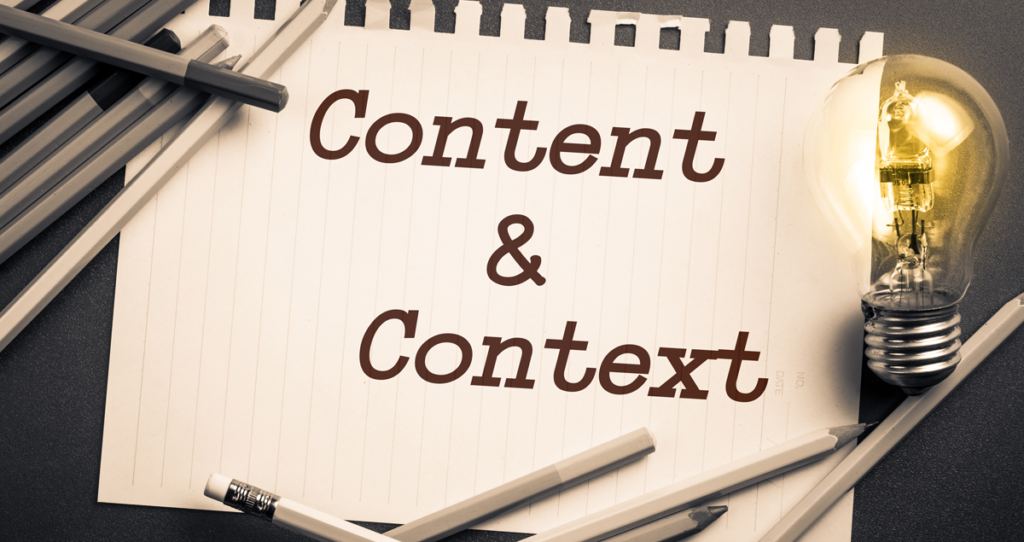
Alright, so now we know we have to use appropriate language and be as specific as we can with our prompts — but there is still one more trick you can use to enhance your chat gpt prompts and that’s providing context.
Providing context is essential to getting accurate and useful responses from ChatGPT. You have to make sure to provide enough context so that ChatGPT can understand the intent behind your prompt.
In our banana example, I’d first ask ChatGPT if it’s familiar with the company it’s trying to produce copy for. If it’s not, feeding it the domain of the company and what you’re all about will be helpful to get ChatGPT to produce the results you’re looking for. Then, feeding it copy from previous ad campaigns, social campaigns, web pages, etc. is a great way to get ChatGPT to learn the tone and writing style of your company.
Part of providing context is also being as specific as possible with what you want your output to look like. In our previous example, ChatGPT was giving me a list of options because I wasn’t being as specific as I could for my output. So, I asked ChatGPT to produce the same examples in a table format. The results are below.
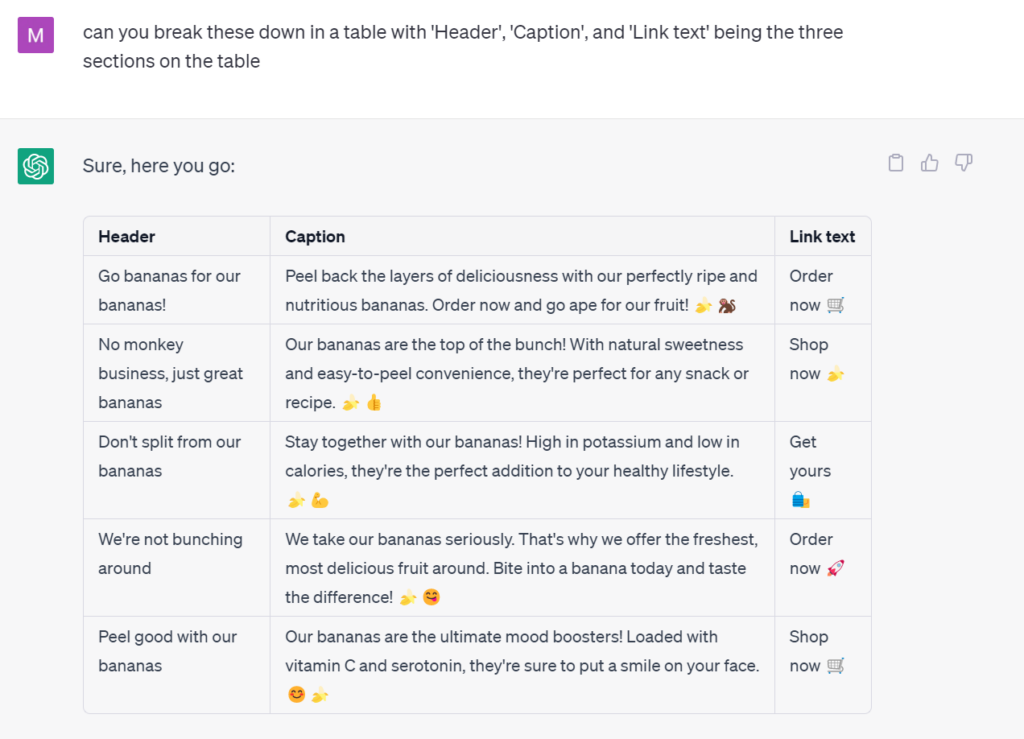
This is just one of many examples where ChatGPT is capable of producing and adapting to so many different things — we just need to know how to prompt the right questions to get what we want from it.
ChatGPT Assisted Help from MINDSCAPE
Writing effective ChatGPT prompts requires a bit of practice and attention to detail, but it’s worth the effort. By following these best practices, you can get the best results from your AI language model, and achieve your desired outcomes. So, take the time to craft effective prompts, and see how ChatGPT can transform the way you work and communicate.
MINDSCAPE uses ChatGPT almost every day so we can deliver more value to our clients than ever before – even the foundations of this blog post were AI assisted. We now get to spend more time considering the best blog structure and strategy to use rather than needing to produce every single sentence from scratch.
When you work with MINDSCAPE, AI will be used to deliver you more value. Learn more about why you should choose MINDSCAPE for your digital marketing needs.




